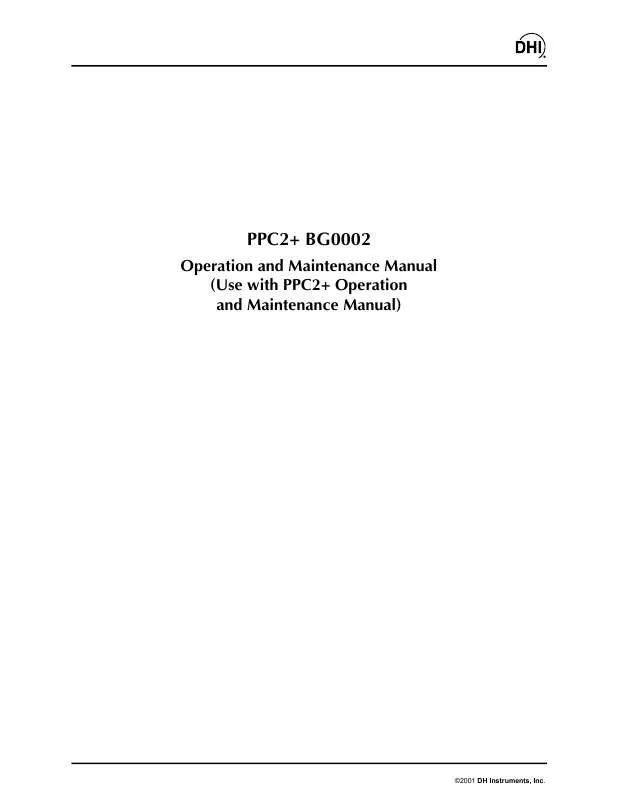User manual FLUKE PPC2
Lastmanuals offers a socially driven service of sharing, storing and searching manuals related to use of hardware and software : user guide, owner's manual, quick start guide, technical datasheets... DON'T FORGET : ALWAYS READ THE USER GUIDE BEFORE BUYING !!!
If this document matches the user guide, instructions manual or user manual, feature sets, schematics you are looking for, download it now. Lastmanuals provides you a fast and easy access to the user manual FLUKE PPC2. We hope that this FLUKE PPC2 user guide will be useful to you.
Lastmanuals help download the user guide FLUKE PPC2.
You may also download the following manuals related to this product:
Manual abstract: user guide FLUKE PPC2
Detailed instructions for use are in the User's Guide.
[. . . ] PPC2+ BG0002
Operation and Maintenance Manual (Use with PPC2+ Operation and Maintenance Manual)
©2001 DH Instruments, Inc.
PPC2+ BG0002 Operation and Maintenance Manual
High pressure liquids and gases are potentially hazardous. Energy stored in these liquids and gases can be released unexpectedly and with extreme force. High pressure systems should be assembled and operated only by personnel who have been instructed in proper safety practices.
© 2001 DH Instruments, Inc. Information in this document is subject to change without notice. [. . . ] The recommended tubing for PPC2+ BG0002 test port connections is 1/4 in. (6 mm) PFA tubing or any other large internal diameter tubing that will not restrict the flow between the PPC2+ and the system under test. For optimal performance it is important that both the TEST(+) and TEST(-) ports of the PPC2+ be connected to the high and low or positive and negative ports of the device or system under test. If no connection is available on the low or negative side of the device or system under test, operation is possible but pressure control and measurement may be adversely affected by instability of ambient pressure in the environment in which the PPC2+ BG0002 is being operated. The PPC2+ BG0002 TEST(+) and TEST(-) connections are both 1/4 in. NEVER connect a pressure supply to the TEST(-) port. The pressure applied to this port should be maintained between 80 and 110 kPa (11. 6 and 16 psia) (roughly atmospheric pressure ± 15 kPa (2. 2 psi) depending on your location. Exceeding these limits may damage the RPT. Operating the PPC2+ BG0002 connected to a system with liquid contaminants without taking proper precautions to purge the system and test line may cause contamination of the PPC2+ BG0002 that will require non-warranty service. Minimizing the length of the test connection tubing will enhance control performance and reduce pressure setting time. For normal operation, the total volume of each side (high and low) of the device or system under test (not including the PK-PPC-BG-DVU accessory volumes) should be between 0 and 1 000 cc (60 in3). PPC2+ BG0002 pressure control will not operate properly if there are excessive leaks in the test system. In general, the maximum acceptable leak rate for optimal PPC2+ automated pressure control operation and to assure in tolerance measurements with default pressure control parameters is ± 1 % of active span FS/minute. In DYNAMIC CONTROL mode, to handle higher test system leak rates, increase the hold limit using CUSTOM CONTROL (see the PPC2+ Operation and Maintenance Manual, Section 3. 2. 6).
©2001 DH Instruments, Inc.
Page 8
PPC2+ BG0002 Operation and Maintenance Manual
PPC2+ BG0002 pressure control may be adversely affected if the test connection tubing is too restrictive. For optimum results, the inner diameter of the connecting hose should be at least 2. 5 mm (0. 1 in. ). For optimum pressure measurement and control, the PPC2+ BG0002 TEST(-) port should be connected to the system or device under test low or negative port.
2. 3. 5. 1
INSTALLING THE SPLT
The SPLT (optional) is intended to collect and exhaust liquid that may be present in the device or system under test so that they do not return to contaminate the PPC2+. With PPC2+ BG0002, the SPLT is installed in the TEST(+) line between the PK-PPCBG-DVU and the system or device under test. No SPLT is needed in the TEST(-) line as there should be no flow in the TEST(-) circuit. Also see the SPLT Operation and Maintenance Manual.
2. 3. 6
THE VENT CONNECTION (VENT PORT)
The PPC2+ BG0002 VENT port is the system vent to atmosphere point. Though a pressure tube can be connected to the VENT port to direct the vented gas flow, a completely unobstructed connection to atmosphere must be maintained for PPC2+ reference pressure measurements to operate normally. The PPC2+ BG0002 VENT connection is 1/4 in. NEVER plug, obstruct or connect a supply pressure to the PPC2+ vent connection.
2. 3. 7
THE ATM REF PASS THROUGH (UNLABELED)
PPC2+ BG0002 does not have an ATM REF pass through. [. . . ] This feature can be useful to return to a normal condition if a faulty Config routine has been activated. Selecting <1Run> will cause the pneumatic module configuration routine to execute. Before running a user Config, be sure the KP-PPC-BG-DVU dual volume unit, and no other volume, is connected to the TEST(+) port. Connect the normal supply pressure to the rear panel SUPPLY port and a vacuum source to the EXHAUST port. [. . . ]
DISCLAIMER TO DOWNLOAD THE USER GUIDE FLUKE PPC2 Lastmanuals offers a socially driven service of sharing, storing and searching manuals related to use of hardware and software : user guide, owner's manual, quick start guide, technical datasheets...manual FLUKE PPC2


 FLUKE PPC2 INSTALLATION (62 ko)
FLUKE PPC2 INSTALLATION (62 ko)
 FLUKE PPC2 INSTRUCTIONAL AID (94 ko)
FLUKE PPC2 INSTRUCTIONAL AID (94 ko)
